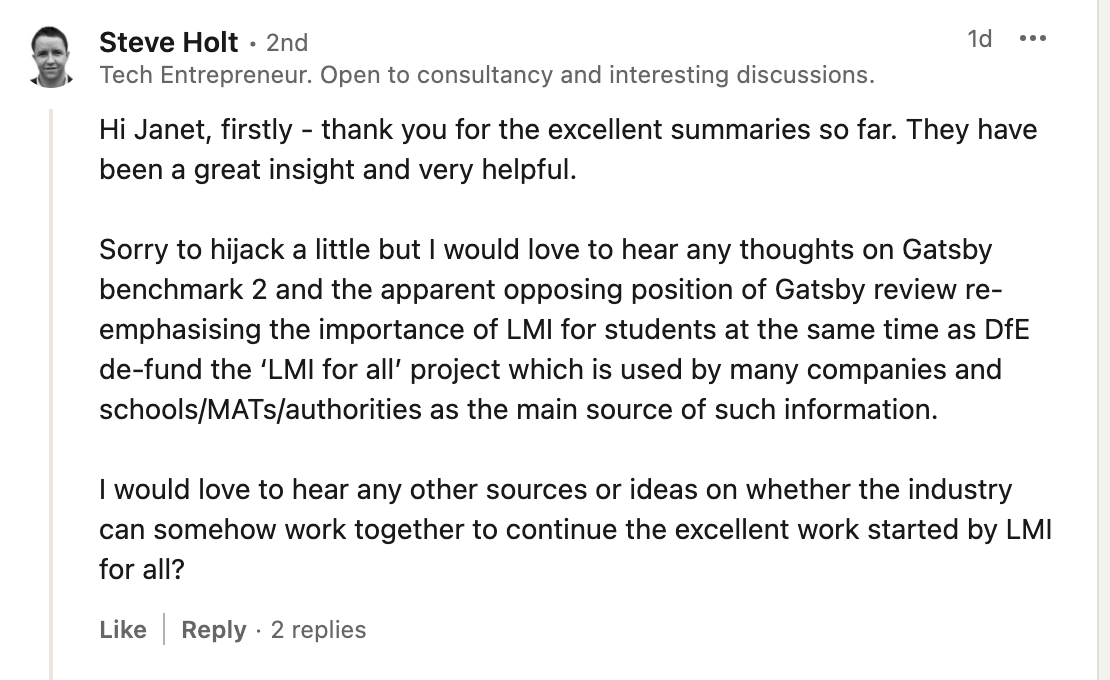Learning from career and LMI & addressing the needs of each young person
AKA How can I teach LMI when I don't understand what it is?
I’ve blogged backwards from Gatsby Benchmark 8 back to 4. Today is the turn of benchmarks 2 & 3, so grab a cuppa and take 5 to read my take on the updates
Gatsby Benchmark 2, Learning from career and labour market information
I know that Labour Market Information (LMI) is one of the areas that many educators and careers professionals struggle with, let alone parents or learners. Not a huge amount has changed but I feel it’s worth outlining here what the expectations were. I’ve highlighted the main changes in bold.
What is LMI?
In it’s simplest form it is information on :-
What skills employers are looking for and what jobs are available
Wage rates, working hours, holiday entitlement etc
What skills gaps exist and what skills are expected to be needed in the future.
All this can be broken down into sectors e.g. hospitality & events management, property and construction etc. If you want a list of all the sectors have a look at the Prospects website it’s pretty comprehensive
What does the statutory guidance say about LMI?
That it should be local i.e. showcase growth sectors in the local economy
It should be sequenced, i.e. it should be introduced at a simple level at an early stage and its use and complexity developed throughout the programme of study. (As in all teaching) LMI was previously only expected to be introduced at the age of 14.
That some groups, namely learners with additional needs, those with mixed or multiple ethnic groups, those in care or those with English as an additional language are likely to need extra support
The benchmark criteria has been extended beyond decisions about study options to include next steps to include those with complex additional needs for whom employment may not be the next step. Careers Leaders should work closely with the SEND coordinator.
Careers Advisers are experts in interpreting LMI (Big up RCDPs and all qualified careers advisers)
Employees & Industry advisers can offer insights but may or may not be experts.
Teachers and staff should be guided towards good quality and up to date LMI
Parents & Guardians may need extra support and schools should consider how best to support their cohorts needs.
Where can I get LMI Support?
Now I should say here that none of the sources of support below, all of which I’ve taken from the guidance, I feel are attractive or accessible for young people and to be honest, I doubt even die hard statisticians would find them easy to navigate. So I’m going to add a shout out to my go to person for LMI, the amazing Helen Janota who works nationally and produces some wonderful LMI resources. (I should point out that I receive nothing for pointing you in her direction, I just like her work and admire it)
I’m also puzzled as was a contact of mine, see above, over the funding being ended for the LMI for All project The data in that is only current up to the end of 2024. It seems shortsighted given the requirements of the statutory guidance. Let’s hope there’s a new resource in the pipeline
Sites recommended in the guidance :-
Jobcentre Plus Support for Schools scheme
Office for National Statistics for information on people in and out of work
Office for National Statistics Market Overview & employment rates
Gatsby Benchmark 3 Addressing the needs of each young person
Mostly GB 3 has stayed the same, however there are some changes to the way that careers leaders deliver and record the programme. I really do suggest that you visit the main download link and download it (Scroll to the bottom, or press ctrl and p, choose print then instead of printing it, save to pdf) You’ll find much more info from page 33) but here are the bare bones

Major Changes
Record keeping, previously it was required that we keep records of individual advice given to pupils. This has now been expanded to “the participation of pupils in all aspects of their career programme”
You must now share the information on their participation in the career programme on when learners change schools. Therefore, I’d assume you need to make sure that you get the records of new pupils from previous schools
ITPs and Colleges to integrate the information from leaners schools into their own recording systems.
Learners should have access to these records and use them in planning their next steps
You must share information with your local authority including name & address and d.o.b; student contact details, information on those at risk of becoming NEET, students post 16 and 18 plans and offers students receive in post 16 or HE
Collection of destinations data has now changed to :-
Schools and colleges should collect, maintain and use accurate data for each learner on their aspirations, intended and immediate education, and training or employment destinations, to inform personalised support.
Schools and colleges should use sustained and longer-term destination data as part of their evaluation process and use alumni to support their careers programme.

OK, just benchmark one to go now, time for a cuppa, I think I deserve it, don’t you? I’ll enjoy reading your comments over my cuppa.





Hi Janet, what are your thoughts on collecting records from schools? I’m thinking an electronic/paper careers record along with GCSE results when enrolling at college/ITP?